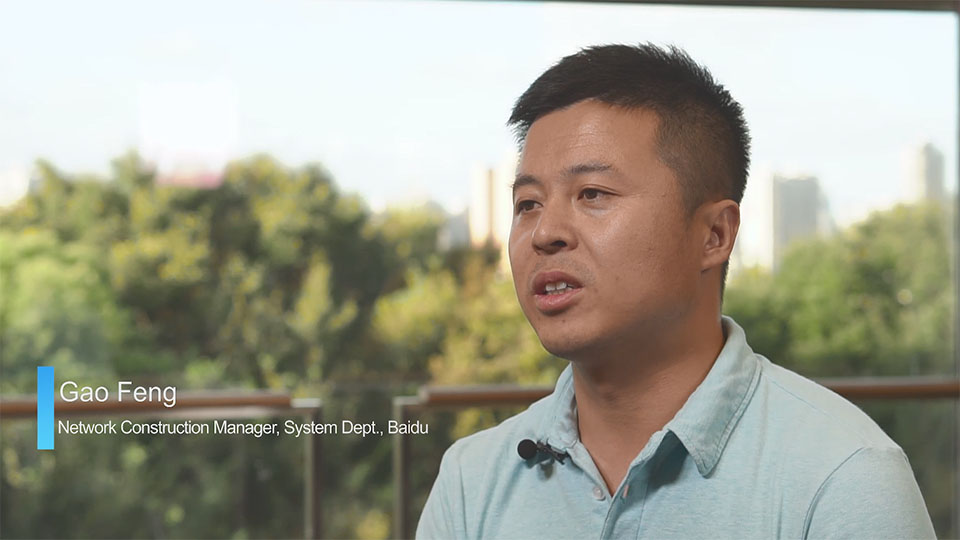Baidu and Huawei Jointly Build an Ultra-Broadband, Intelligent, and Simplified Data Center Interconnect (DCI) Network
Produkty, Rozwiązania i usługi dla przedsiębiorstw
Baidu is the world's biggest Chinese search engine and website provider and a leader in artificial intelligence. Baidu processes billions of search requests from more than 100 countries and regions, and is the main portal for accessing Chinese content online. Its mobile app, Baidu Mobile, has more than 1.1 billion monthly active devices.
Baidu Mobile amassed over 300 million of the daily active users on Chinese New Year's Eve 2019, acting as the official platform for sharing "virtual red packets" during the 2019 CCTV Spring Festival Gala — China's annual variety show that has the largest audience of any entertainment show in the world. (Virtual red packets are based on the Chinese tradition of giving money to friends and family in the form of a red packet, or red envelope.) The number of interactions with the worldwide audience reached 20.8 billion, with a peak request rate per second of 50 million and a peak request rate per minute of 1 billion, marking the largest traffic volume due to sharing red packets in history. How did Baidu cope with such heavy traffic during the Spring Festival Gala? This is all down to the ultra-high-bandwidth DCI network.
How did the ultra-high-bandwidth DCI network overcome all the challenges typical to data center (DC) networks? For example, the heat dissipation, power supply, installation mode, and device form factor of existing modular-configuration optical transmission devices cannot match the installation environment of the DC equipment rooms. As a result, the equipment rooms need to be reconstructed, lowering the engineering efficiency.
In addition, traditional optical transmission devices require complex optical-layer fiber connections and configurations, which demands highly skilled and experienced O&M personnel. Incorrect fiber connections interrupt services, and the impact increases each year as the number of services grows. The planning, deployment, and commissioning of traditional optical transmission devices require at least half a month, failing to meet the requirements for fast rollout of cloud services.
Moreover, software interfaces are not unified, making it difficult for automation development. The same function needs to be adapted to proprietary interfaces of different vendors. As a result, the SDN platform cannot control devices and is unable to meet the requirements for automatic and intelligent O&M.
To address these challenges, Baidu and Huawei jointly analyzed the challenges and future development trends of DC networks, discussed technical innovations, and developed the industry-leading next-generation DCI solution. The solution reduces the per-bit cost, simplifies O&M, and enables fast site deployment for Internet and enterprise customers. Fast network construction and intelligent O&M can be performed by IT personnel, with no need for specialist optical transmission O&M capabilities. The following describes how this is achieved:
The new DCI transmission devices are highly compatible with the existing DC equipment room environment, and therefore require no reconstruction of the equipment room. For example, the new devices support 220 V AC or 240 V DC power supply, adopt the front-to-rear airflow design, support optical-electrical integration to improve integration, and support 120 wavelengths by utilizing the Super C band. In addition, the per-fiber capacity exceeds 48 Tbit/s. This reduces required optical fiber resources and per-bit cost while improving the data transmission speed. The 200G e16QAM coding technology doubles the maximum transmission capability, saving electrical regeneration resources and ultimately reducing costs.
To achieve simplified O&M and fast deployment, Huawei has innovated technologies and product architectures. As a result, no site survey is required, reducing fiber connections, avoiding incorrect fiber connections, and improving engineering efficiency. One-click automatic deployment reduces the configuration and commissioning time from days to minutes. In addition, Huawei and Baidu work together to introduce intelligent O&M, lowering required expertise of personnel and transforming O&M from reactive to proactive. In addition, a unified network management system (NMS) is developed, using standard interfaces and models to perform centralized operations and monitoring of devices. This fully meets requirements for automatic O&M by making transmission O&M simple enough for IT personnel, reducing operating expense (OPEX).

Liu Ning, Director of Baidu's System Department, also shared experience in building the DCI network of Baidu, as well as their future plans: "Baidu and Huawei have cooperated closely, jointly developing the industry-leading next-generation DCI solution through technical innovations. The simplified configuration and intelligent O&M reduce network O&M costs, increase the per-bit value, and build a non-blocking, flexible, and intelligent DCI network. At Baidu, we are looking forward to cooperating in more projects with Huawei in the future to explore the development direction of the DCI industry and jointly create an intelligent future."